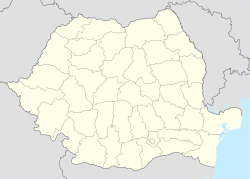
The Limes Alutanus was a fortified eastern border of the ancient Roman province of Dacia built by the Roman emperor Hadrian to stop invasions and raids from the east.

Arutela was an ancient Roman fort in the Roman province of Dacia today near the town Călimănești. It lies on the left bank of the Olt River. It was part of the Roman frontier system of the Limes Alutanus.

Praetorium II (Racovița) was a fort in the Roman province of Dacia near the present village of Racovița, Vâlcea. It was built in the middle of the 3rd century, part of the Roman frontier system of the Limes Alutanus along the Olt (river) and was the largest fort in the mountain area of the Limes.

Angustia was a fort in the Roman province of Dacia in the 2nd and 3rd centuries AD today near the town of Breţcu, Romania.

Castra Arcidava was a fort in the Roman province of Dacia in the area of the town of Arcidava in the 2nd and 3rd centuries AD.

Castra Buridava was a fort in the Roman province of Dacia, part of the frontier system of the Limes Alutanus, and near the Dacian and Roman town of Buridava.

Castra of Boroșneu Mare was a fort in the Roman province of Dacia in the 2nd and 3rd centuries AD. A contemporary settlement was also unearthed at the fort. Its ruins are located in Boroșneu Mare in Romania.

Ulpianum was a fort in the Roman province of Dacia. Traces of the castra built in the 2nd century AD can be identified at the confluence of the rivers Someșul Mic and Căpuş in the Bánffy Castle's park at Gilău (Romania). A vicus developed south and west of the fort. A large building, 41x41m, within the fort is considered to have been either a valetudinarium or a fabrica.

The castra of Hoghiz was a fort in the Roman province of Dacia. The fort was built in the 2nd century AD, on the left bank of the Olt River, at a place where a Dacian settlement existing already in the 2nd century BC was unearthed. The fort and the nearby village were abandoned in the 3rd century AD. The ruins of the castra are located in Hoghiz, Romania.

The castra of Olteni was a fort in the Roman province of Dacia. It was built in the 2nd century AD. The archaeological site yielded coins issued by the Roman emperors Titus Flavius Vespasianus, Domitian, Trajan, Antoninus Pius, Elagabal and Alexander Severus. The fort was abandoned in the 3rd century. It ruins are located in Olteni in commune Bodoc in Romania.

The castra of Cincșor was a fort in the Roman province of Dacia in the 2nd and 3rd centuries AD and part of the frontier system of the Limes Alutanus.
The castra of Drumul Carului was a fort in the Roman province of Dacia near Moieciu, Romania.

Praetorium I (Copăceni) was a fort in the Roman province of Dacia near the present village of Copăceni, Racovița, Vâlcea, Romania. It was part of the Roman frontier system of the Limes Alutanus along the Olt (river). It was built in 138 and reinforced with two towers two years later.

Gresia Roman fort is located in the present Gresia. It was in the Roman province of Dacia and dates from the 2nd and 3rd centuries AD. It was part of the frontier system of the Limes Transalutanus.
The castra of Livezile was a castra in the Roman province of Dacia, located in the north side of the modern commune of Livezile in the historical region of Transylvania, Romania. The fort was erected and surrounded by a ditch in the 2nd century AD. The castra was abandoned in the 3rd century and its ruins are still visible.

The castra of Pietroasele was a Roman fort in Roman Dacia located in the centre of Pietroasele (Romania). It was built under Trajan after Trajan's Dacian Wars in about 106 AD but abandoned at the beginning of Hadrian's reign when Wallachia was given up to the Roxolani. It was used again at the beginning of the 3rd century in the reign of Caracalla. It was rebuilt by Constantine the Great after his victory over the Goths in 328 when Constantine created the Constantine Wall of the Dacian Limes. It was abandoned in the same century.

The castra of Feldioara was a fort in the Roman province of Dacia
The Castra of Jac was a fort made of earth in the Roman province of Dacia. It was erected in the 2nd century AD. Not far from the fort, the remains of a previous fortification and of a Roman watchtower were unearthed. The fort and the watchtower were abandoned in the 3rd century. Traces of the castra can be identified on Citera Hill in Jac. The fort was manned by a Palmyran numerus with a detachment of horse-archers.

The castra of Bumbești-Jiu now known as Gară was a fort in the Roman province of Dacia located in Bumbești-Jiu (Romania). It replaced the nearby earlier fort of Castra of Bumbești-Jiu – Vârtop in the 2nd century AD. It defended and secured the entrance to the Jiului gorge and the Roman road from Bumbești through Porceni over the mountains, through the Vâlcan Pass to Sarmisegetuza.

The castra of Bumbești-Jiu now known as Vârtop was a fort in the Roman province of Dacia. It is located 35 m west of the Târgu Jiu - Petroșani road, in Bumbești-Jiu (Romania). It defended and secured the entrance to the Jiului gorge and the Roman road from Bumbești through Porceni over the mountains, through the Vâlcan Pass to Sarmisegetuza.














